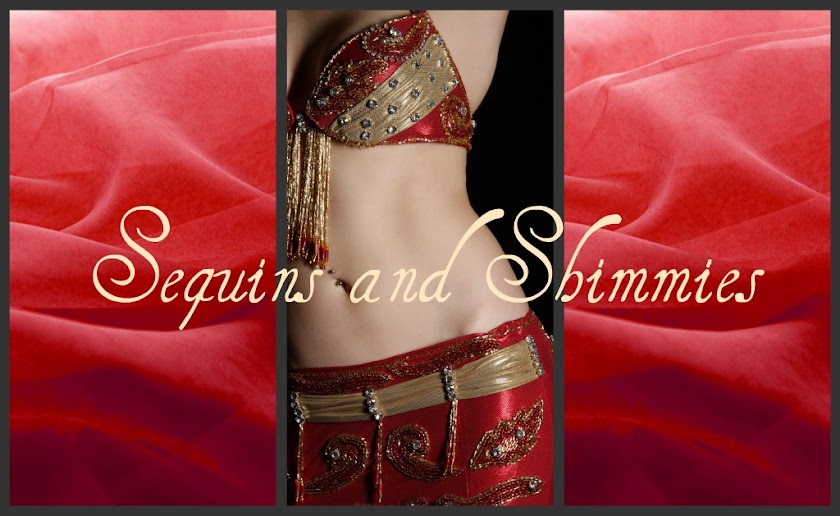If you want
to be a Middle Eastern dancer, you need to be familiar with Middle Eastern
music. Thus this week we are going to
explore five classic songs every belly dancer should know. This post isn’t intended to be a list of the
five most important songs per se, and it’s certainly not an exhaustive list, but we
are sticking with five for purposes of simplicity. If are you just getting your feet wet with
Middle Eastern music, these five songs will be a good jumping off point for you
to start discovering more on your own.
There's a couple names that you'll hear repeatedly over and over again below, so I want to say a few words about those individuals before we go any further. The first is the composer Mohammed Abdel Wahab. Wahab was born in 1902 in Cairo and indelibly left his mark on Egyptian music. During his lifetime, he was not only a composer, but also a singer, poet, and oud player. He was known for, and even at times criticized for, incorporating western rhythms into his music. Wahab worked closely with and composed 10 songs specifically for our second artist of importance, the legendary Oum Kolthum.
Kolthum is quite arguably the greatest Arabic female singer of all time. She was born in the village of Tamay e-Zahayra, and it's uncertain as to whether she was born in 1898 or 1904. The 1940s and 1950s are known as her golden eras of singing. During this time, Kolthum had a monthly radio concert. These concerts were epic events lasting hours at a time, and they could clear the streets of bustling cities as residents rushed home to hear her broadcast. Kolthum is known for her exacting vocal control and emotive vocal impact, and her songs frequently touched the universal emotions of love, loss, and longing.
Alright, let's see how these individuals, as well as others, collaborated to produce our five songs of the week. Hundreds of versions by various musicians have been produced over time for each of these pieces. To help newer listeners navigate, I've also included a suggested version that I've enjoyed using in my classes, performing to, or both.
There's a couple names that you'll hear repeatedly over and over again below, so I want to say a few words about those individuals before we go any further. The first is the composer Mohammed Abdel Wahab. Wahab was born in 1902 in Cairo and indelibly left his mark on Egyptian music. During his lifetime, he was not only a composer, but also a singer, poet, and oud player. He was known for, and even at times criticized for, incorporating western rhythms into his music. Wahab worked closely with and composed 10 songs specifically for our second artist of importance, the legendary Oum Kolthum.
Kolthum is quite arguably the greatest Arabic female singer of all time. She was born in the village of Tamay e-Zahayra, and it's uncertain as to whether she was born in 1898 or 1904. The 1940s and 1950s are known as her golden eras of singing. During this time, Kolthum had a monthly radio concert. These concerts were epic events lasting hours at a time, and they could clear the streets of bustling cities as residents rushed home to hear her broadcast. Kolthum is known for her exacting vocal control and emotive vocal impact, and her songs frequently touched the universal emotions of love, loss, and longing.
Alright, let's see how these individuals, as well as others, collaborated to produce our five songs of the week. Hundreds of versions by various musicians have been produced over time for each of these pieces. To help newer listeners navigate, I've also included a suggested version that I've enjoyed using in my classes, performing to, or both.
Aziza
One of the most recognizable Middle Eastern tunes of all time. This song was composed by Mohammed Abdel Wahab and made famous in the 1955 movie of the same name, when it was first performed to by Naima Akef. You can check out the video clip from the movie below.
Version to Try: Aziza (Arabic Popular Music Instrumental) from the album Oriental Guitar - Turkish & Arabic Music Instrumentals by Rashed el Youssef
Alf Leyla Wey Leyla
Another instantly recognizable melody. This piece was composed by Baligh Hamdi and sung by the legendary Oum Kolthum. The original song is over 40 minutes long, with the singing starting shortly after eight minutes in.
Version to Try: Alf Leyla, Wa Leyla from the album A Tribute to Om Kalsoum by The Cairo Orchestra
Leylet Hob
Another one by Mohammed Abdel Wahab, written especially for Oum Kolthum. The clip below shows the famous Soheir Zaki dancing to the piece. Listen closely and you'll hear that Wahab specialty of mixing Western rhythms into the piece as well.
Version to Try: Leylet Hob from the album 10 Songs Every Belly Dancer Should Know by Andelus Ensemble
Enta Omri
A hauntingly beautiful song by again the same dynamic duo team of Mohammed Abdel Wahab and Oum Kolthum. This was another song that was a long one, originally about 40 minutes. Entra omri means "you are my life" and the lyrics are a soulful love song. Shira's website includes an extensive translation. The clip below is just a piece of the original, but I like that it displays the translation as she's singing.
Version to Try: Enta Omri from the album The Rough Guide to Bellydance by Jalilah and featuring Mokhtar Al Said
Zeinah
Give you one guess on who composed this one? Yup, it's another Mohammed Abdel Wahab. Zeinah means "the beautiful", and it shot to popularity when it was danced to by the beautiful Samia Gamal in the 1956 movie Zanouba.
Version to Try: Zeinah from the album House of Tarab by House of Tarab

